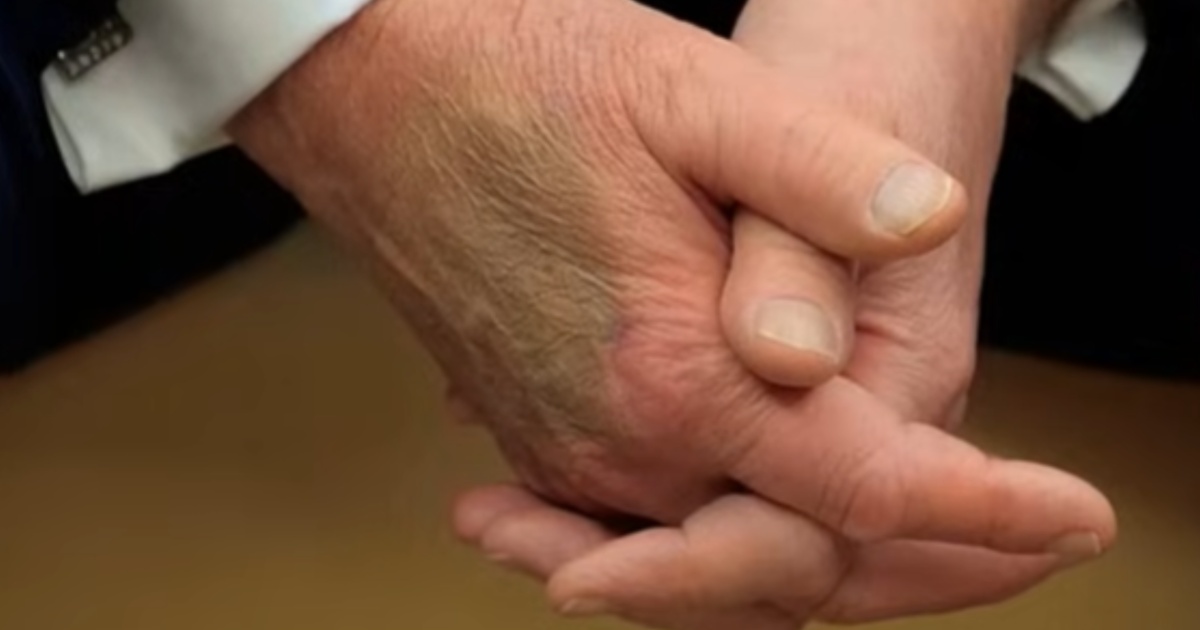Donald Trump’s hands are once again at the center of attention, this time because of a series of mysterious bruises that have fueled a frenzy of speculation online. The 79-year-old president’s health has been under scrutiny for years, and the appearance of discolored patches on the back of his hands prompted critics and supporters alike to take to social media with theories ranging from medical concerns to poorly applied makeup.
The chatter reached such a pitch that the White House was forced to respond. Press Secretary Karoline Leavitt confirmed the president underwent what she described as a “comprehensive exam” that included vascular testing. She revealed that Trump suffers from a chronic vein condition and suggested the bruises were the result of tissue damage caused by “frequent handshaking” while also taking aspirin, which thins the blood.
“President Trump is a man of the people, and he meets more Americans and shakes their hands on a daily basis than any other President in history,” Leavitt said. “His commitment is unwavering, and he proves that every single day.” Still, the official explanation did little to quiet the noise.
To cut through the speculation, dermatologist Dustin Portela, who is certified by the American Board of Dermatology, weighed in with a detailed YouTube video. Portela explained that the bruises are most likely the result of age-related skin changes combined with the physical stress of constant handshakes. “He’s got a bruise on the back of his hand due to shaking hands with so many people as president of the United States,” Portela said. He pointed to images of Trump greeting U.K. Prime Minister Keir Starmer, where the stretching of Trump’s skin during the handshake was obvious.
The doctor noted that as people age, starting around 25 or 30, they lose about one percent of collagen in the skin each year. Collagen, he explained, provides thickness and resiliency, while elastin ensures the skin can bounce back after being pulled. By the late 70s, those protective layers are far thinner, leaving blood vessels much more vulnerable. “If you don’t have a lot of collagen to protect the blood vessels, it doesn’t take much to get bruising,” Portela said.
Close-up photos of Trump’s right hand. pic.twitter.com/csQRTCGYM5
— Blue Georgia (@BlueATLGeorgia) August 25, 2025
He added that Trump’s lifestyle, especially years of sun exposure from his frequent golfing, likely contributed to thinning skin and weakened vessels. Portela concluded that the White House’s explanation of handshake-induced bruising was “completely plausible” and said that sometimes “the simplest explanation is the most reasonable.”
WH Press Secretary Karoline Leavitt:
“Recent photos of the president have shown minor bruising on the back of his hand. This is consistent with minor soft tissue irritation from frequent handshaking… The president remains in excellent health.”
(July) pic.twitter.com/XgDSnEYoRv— Republicans against Trump (@RpsAgainstTrump) August 23, 2025
That hasn’t stopped the gossip mill. Some critics say the bruises highlight Trump’s advanced age and question whether his health is robust enough for the grueling demands of the presidency. Others dismiss it as another round of overblown speculation. Trump himself has stayed quiet on the issue. However, his visible marks, paired with recent unflattering photos showing his famously thinning hair after removing a helmet, have only kept his appearance in the spotlight.
For now, the bruises on Trump’s hands seem less like a dire health warning and more like the predictable toll of age, sun, and a relentless schedule of public glad-handing. But in Washington, even a simple skin bruise can turn into a political Rorschach test, with everyone seeing what they want to see.









